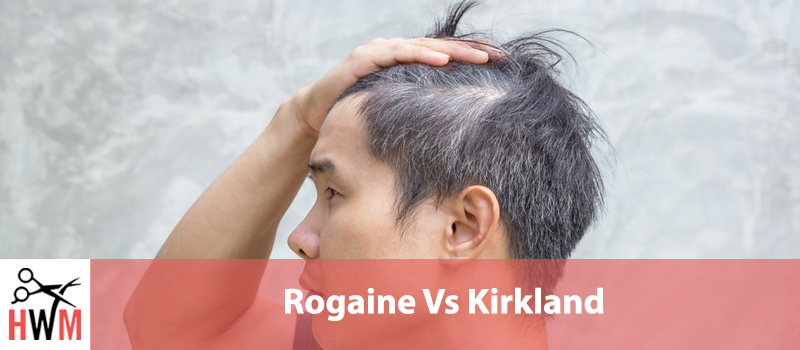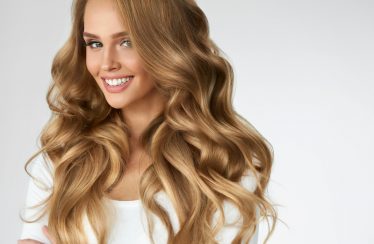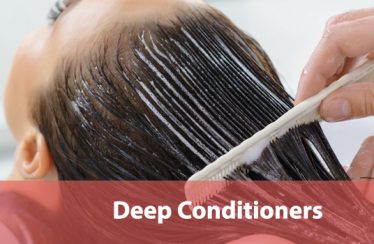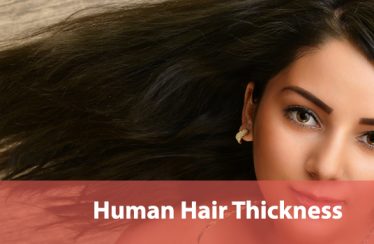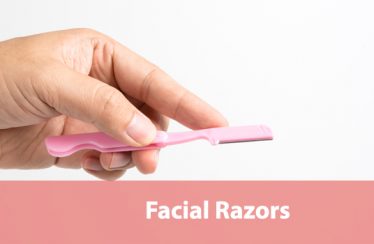Since Rogaine has been on the market as an FDA approved hair loss treatment it has plenty of name recognition. Chances are if you have or suspect you have hair loss you’ve considered starting treatment with Rogaine.
Despite Minoxidil being the only FDA approved over the counter hair loss treatment, there are now Rogaine competitors on the market with the same key ingredient and, supposedly, similar results.
Kirkland, Cost Co’s generic brand, is one of Rogaine’s main competitors. Kirkland only offers a 5% formulation, meaning it’s only suitable for men, but does it work as well as Rogaine?
How Does it Work?
Although minoxidil has been a known effective hair treatment for decades, we still don’t entirely understand the mechanism behind its effectiveness. However, there is one prevailing theory.
Minoxidil was not originally formulated to be a hair loss treatment. That use for the drug was discovered after it hit the market as a blood pressure medication, an unanticipated side effect of the drug.
The hair growth from oral versions of Minoxidil wasn’t predictable, and often the hair growth appeared in unwanted areas instead of just improving hair growth on the top of your head.
So, the drug was reformulated as a topical treatment and tested to see if it still stimulated hair growth. It did.
The main theory behind its effectiveness as a treatment for hair loss is that it works for the same reason it was a good blood pressure treatment. Minoxidil functions as a vasodilator, relaxing blood vessels to allow for freer blood flow.
It is thought that relaxing the blood vessels in the scalp allows for increased circulation to and around individual hair follicles, encouraging them to grow larger and to spend more time in their active growth phase instead of in a holding or resting phase.
Since the growth cycle of hair follicles on your scalps lasts for years at a time, having more follicles in a growth phase at once, and letting the growth phase last longer, leads to denser healthier hair.
Among other similarities, both Rogaine and Kirkland Minoxidil offer 5% minoxidil as the effective ingredient working to restore your hair.
Similarities
Hair loss treatments share a large portion of common traits, and Rogaine and Kirkland Minoxidil are no different. A lot of the main features of these treatments are features they share.
Foam Formula
Both Kirkland and Rogaine offer a foam formula for easy application to your hair. Their foams both dry in about 10 minutes, although they are slightly different in texture.
The foams are also a good option for lots of control over where the treatment is applied. Minoxidil is a non-discriminatory treatment, it works regardless of where it is applied. One common side effect of minoxidil use is unwanted hair growth on your forehead or the tops of your ears.
Using a foam version makes it simpler to avoid getting the treatment anywhere you don’t want it.
Both foams also have an advantage over the liquid serum versions in that you can continue to use other styling products with the foam. You do need to wait for the foam to fully dry before you can style your hair, but since it dries in about 10 minutes, that wait isn’t too significant.
Both formulations will quickly transition from a foam to a thin liquid once applied to your hair and scalp, which makes it easier to work the foam down from your hair to massage directly into your scalp.
Serum Formula
Kirkland and Rogaine also both offer a serum or liquid formulation that lets you apply a bit more directly on to your scalp, but which takes longer to dry and can be a little harder to control.
The serum doesn’t allow you to style your hair for at least 4 hours after you apply it and is more likely to run into your face or onto your ears.
However, you can get it directly on your scalp, and the application, which takes several minutes of massage directly into the scalp for maximum absorption, is also beneficial for hair growth and stimulating circulation to the follicles.
There is also some anecdotal evidence that the serum penetrates the scalp more deeply, leading to slightly better results.
The main reason the serum might be more effective is that it can do more to increase circulation throughout the skin on your scalp instead of only near the surface, bringing more oxygen and circulating more nutrients to your hair follicles.
Both brands also provide a specialized applicator for the serum version, as well as specific directions for how to apply their formulation for the best results.
Ingredients
Both brands use 5% minoxidil, the more effective concentration, although Rogaine also offers a 2% formulation suitable for women.
Both brands also contain propylene glycol, which serves several purposes. For one thing, propylene glycol helps keep the products’ shelf-stable and makes it easier to ship them. Propylene glycol is often used as a form of anti-freeze and serves that function in both of these products.
Propylene glycol is also thought to aid in absorption, carrying the minoxidil deeper into the skin so that it can be more effective.
It’s possible also mildly moisturizing, which is part of why it is a common ingredient in many shampoos and conditioners as well, although we don’t know for sure that it is a good moisturizer.
There is a slim risk, with both products, that the propylene glycol might irritate your scalp.
How Long Until It Works

Another similarity between both Kirkland Minoxidil and Rogaine is how long it takes to see results. Because both products are working to improve the health and size of your hair follicles they have to work with the natural hair growth cycle on your scalp.
For most people, your scalp hair follicles have a several year cycle of growth, most of which is spent in an active growth phase, anagen. However, hair loss causes your follicles to spend more time in shedding and resting phases, or to stop entering anagen all together.
Since minoxidil nudges your hair follicles to spend more time in anagen, you still need to wait about 3-4 months for your hair to go through the other growth phases and get back to anagen.
The good news is that both products actively improve the health of your follicles during that wait time.
However, both require that you use the product consistently for the whole 3-4 months to see results, and you’ll need to continue using them forever.
Or, at least until you’re ready to let your hair loss progress and the new hair the products let you grow fall out.
Both products also go through similar working phases. Minoxidil usually causes some hair loss in preparation for the new hair. That phase typically starts about 2-3 weeks after you start using the product, and can last as little as a week or two or all the way until the new hair starts to grow in.
Both products also have users noting that they seem to lose some effectiveness over time, although that may also be the effect of progressive hair loss counteracting the early effect of the minoxidil.
If you have more damage and hormonal changes to fight to keep your hair, it only makes sense that the minoxidil won’t work as well.
Differences
Of course, every formulation, even of the same drug, has some differences. While those differences don’t involve the effective ingredient in this case, they can make a significant difference in how effective the product is.
There are also other considerations, like price, that might influence your decision as well.
Ingredients
In addition to the ingredients common to both products, there are some differences.
Rogaine contains several ethanols, including stearyl alcohol, which can also aid in absorption. Ethanol, specifically the types beginning with S and C, are also thought to be mildly moisturizing, although, like propylene glycol, they can be mildly irritating or drying for some people. It all depends on your skin.
Rogaine also contains vitamins that Kirkland doesn’t, which can create a difference in results and absorption since Rogaine contains some of the nutrients needed for healthy hair growth, giving an immediate boost as the minoxidil works.
Additionally, Rogaine contains ingredients that help remove and discourage DHT (dihydrotestosterone), one of the more aggressive and effective forms of testosterone.
Although it is not known why DHT discourages the thicker and more robust hairs known as terminal hairs from growing when it binds to hair follicles in your scalp.
DHT can encourage thicker terminal hair growth elsewhere, like your facial hair, but reducing the DHT binding to the follicles in your scalp will help encourage stronger thicker hair growth.
Kirkland doesn’t mimic those ingredients, relying instead on the minoxidil alone since only the minoxidil is FDA approved as a hair loss treatment.
Price
It should be no surprise that Kirkland, which is both a generic version and benefits from the Cost Co membership discount, is significantly cheaper than Rogaine.
Rogaine is approximately $30 a month, although you can occasionally get a deal on the product or bring the price down somewhat by signing up for a long-term subscription.
Depending on how much the discount is as your local Cost Co, you can get 6 to 12 months of Kirkland Minoxidil for the same cost as 2 months of Rogaine.
Cost matters in a product like this, that you’ll be using for years to come. It’s no small advantage that Kirkland is significantly cheaper and can be bought in bulk.
Texture
Rogaine is well-known to be a drying product. It causes some dryness in hair and scalp, especially as you first start to use it, and it can make the skin on your hands dry as well.
Even though the overall effect of the Rogaine is drying, it feels oily on your skin as you apply it. That can be helpful because you need to wash away any Rogaine in an unwanted area quickly. If it stays on your hands and face it will stimulate hair growth in those areas as well.
Kirkland comes out greasier feeling, both on your hands and on your hair. You may be tempted to wash your hair more often using Kirkland’s Minoxidil, although you should try to stick to your normal routine since washing too often is also damaging and drying.
If you do have to wash more often, try to hold off until your hair is showing the grease and buildup from the product, and try to wash your hair at least 4 hours after you apply the treatment. You may also want to apply more as soon as your hair is dry again after showering, that way you minimize the amount of time your hair goes without the benefit of the treatment.
Kirkland’s formulation also seems to be and stay greasier on your hands and skin. Anecdotally it is also less drying for both skin and hair, although a direct scientific comparison of the drying or moisturizing effect has not been done.
Availability
Another important consideration is how difficult it might be to get your hands on your product of choice. Rogaine is available to anyone, you can find it in stores or order it online direct from the manufacturer.
Kirkland Signature, on the other hand, is mostly available through Cost Co. You can order Kirkland Minoxidil through Amazon, but it won’t be available at brick and motor stores outside of Cost Co. It’s also noticeably more expensive through Amazon.
Although even ordering through Amazon and not getting the Cost Co discount, Kirkland Signature is still slightly cheaper than Rogaine.
Note: It’s worth noting that there are several Amazon reviews for Kirkland Signature that have a significant quality difference between Kirkland Minoxidil bought at a Cost Co and the version bought online.
The issues ranged from possible shipping damage (missing product packaging and seals) to customers saying that the product from Amazon stopped working and they lost the progress they’d made using Minoxidil products, but that their hair grew back as soon as they switched back to the store-bought version.
Comfort
Comfort is important in a product you’re going to use at least once a day, and maybe twice. Unfortunately, the comfort of these products does seem to vary between users, but neither product is more or less likely to be comfortable.
Both products have a possible side effect of a burning sensation, which can be mild and tolerable, or intense and highly uncomfortable. Even painful, if your skin is particularly sensitive to one or more of the ingredients.
However, it is worth noting that many users who complain of intense or uncomfortable burning sensation with Rogaine don’t experience the same discomfort using Kirkland’s Minoxidil, and vis versa.
Subscription Vs. Bulk Buying
Another consideration is how you can buy the product, and how often you’ll need to put it on your list. Since these are lifetime products, it’s much easier to buy them more than one month’s supply at a time.
Fortunately, both brands have options to make it easier to keep the product around.
Kirkland, being a Cost Co brand, comes in bulk. Depending on where you buy, in-store or online, you can typically get it in 3- and 6-month packages, and sometimes you may be able to get a deal on a 12-month supply.
Rogaine doesn’t often come in bulk packages, although, again, the exact package size varies regionally and by retailer. However, you can buy Rogaine directly from the brand online, and they do offer subscription packages that will ensure you get your supply regularly and don’t have to worry about running out and needing to make an emergency trip to the store.
The subscriptions are also fairly flexible, varying from a 1-month supply delivered at a time, all the way through a 12-month subscription.
Subscribing does offer a discount, bringing the price down closer to Kirkland Minoxidil. But, setting the subscription up on a recurring basis (which gives you the discount) also makes it easier to accidentally buy more than you need if you ever decide to stop using Rogaine, or switch products.
Which Product Is Better?

We’ve mentioned before that only the Minoxidil, the main active ingredient in both of these hair loss treatments, is FDA approved as an effective treatment.
Despite the formula differences, from a scientific perspective, both of these products should be equally effective.
That said, anecdotally the Rogaine formula seems to be more effective for a lot of folks who initially start with Kirkland or another generic competitor and then switch to Rogaine to see if they can get better results.
That said, plenty of people get great results from Kirkland, and it seems to cause a burning sensation and other uncomfortable reactions less often than Rogaine does.
Ultimately, since they use the same active ingredient, and both brands offer it at the higher approved concentration (although Rogaine also offers a 2% concentration which Kirkland does not) it is up to you and what your comfort level is which product you want to use.
The subscription offered by Rogaine is a slightly more convenient method of getting the product.
Even though you can bulk order Kirkland Minoxidil online, there are enough reports of the Amazon version being less effective or possibly counterfeit for it to be a riskier proposition than ordering directly from Rogaine.
But if you struggle with dry skin or uncomfortable side effects using Rogaine, you should probably give Kirkland a try and see if you get better results from the slightly different ingredient list.
FAQ’s About Minoxidil
Q: How old do you have to be before you can start using Minoxidil for hair loss.
A: You should be at least 18 years old before you start using any Minoxidil products. If you’re starting to experience hair loss under 18, it’s a good idea to consult a dermatologist or doctor to see if there is some medical cause other than genetic hair loss.
Q: How much hair do you really get back with Minoxidil products?
A: Actual results vary a great deal between individual users. Most people will see some hair restoration, but those results can be significant, meaning almost total hair restoration, or minimal, meaning just barely visible.
Minoxidil works better for men under the age of 40, and best if you catch your hair loss early. Minoxidil does help regrow some hair, but most users find that it is most effective in protecting the health of existing hair and hair follicles.
Q: Why does your hair fall out when you first start using Minoxidil?
A: The sudden increase in hair loss that comes with early Minoxidil use can be upsetting. Fortunately, the mechanism behind the hair loss is to your benefit.
The hairs you lose in the first few weeks of using a Minoxidil product are hairs that were already in the holding phase, meaning the follicle was holding on to the hair strand but wasn’t growing.
By encouraging your follicle to release the hair more quickly, Minoxidil helps move more of your hair follicles into active growth at once, resulting in thicker, healthier-looking hair.
Q: Are there any side effects of Minoxidil I should worry about?
A: Of course, if you are concerned about any of the side effects of Minoxidil, or notice those side effects getting worse, you should consult with a dermatologist or doctor to make sure nothing more serious, like an allergic reaction, could be causing the problem.
However, you should always be concerned if you have any symptoms of Minoxidil use that are more uncomfortable than you can reasonably tolerate.
Burning and itching are both common reactions, but they should be tolerable. Extreme burning and itching are not normal.
If your skin starts to redden, flake, or show any other signs of a rash you should discontinue Minoxidil use and get in touch with your doctor.
Q: Can you use Minoxidil products with psoriasis, acne, or other skin conditions?
A: If you know you have a skin condition that may interfere with using Minoxidil you should consult a dermatologist before you start with any Minoxidil product. Even with dermatologist approval, you should avoid using Minoxidil products over any active sores or rashes as the product may further irritate and damage the skin in those areas.
